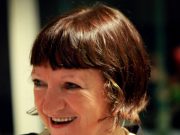
For the English version, please, scroll down.
Dal 25 al 28 aprile, presso il Volksbühne Berlin, è andato in scena Rauschen, produzione del 2019 della Sasha Waltz & Guests.
Lo spettacolo inizia con un brano dei Beatles che suona mentre le luci in sala sono ancora accese.
La prima ad apparire sul palco è una donna vestita in bianco che si muove come un robot. Ha un pensiero che non le da pace, sente la mancanza di “lui”. La sua interlocutrice, incapace di empatizzare, la invita a rilassarsi. Intanto entrano in scena altri danzatori che indossano bellissimi costumi interamente bianchi o neri. Tutti hanno le stesse movenze robotiche che a volte ricordano i gesti ripetitivi di una catena di montaggio, alcuni, però, svelano i loro sentimenti (c’è chi racconta delle proprie paure, chi non è contento delle proprie sembianze fisiche, chi ha perso la ragione, chi vorrebbe una casa più grande…) mentre altri sembrano essere delle “macchine” incapaci persino di un abbraccio.
Dopo un momento poetico, di chiari scuri e ombre sul fondale, vengono portati in scena diversi oggetti. In un crescendo sempre più vorticoso e incalzante di azioni, prendono vita immagini sapientemente accompagnate da cambi di luce, musica, suoni, costumi, che ne rendono l’impatto visivo ancora più suggestivo.
Sul fondale compaiono delle scritte, un uomo aggrappato a un trapezio elenca una serie di diritti umani inalienabili, fino a cadere a terra sfinito. Uno ad uno tutti i danzatori imprimono parti del loro corpo su lavagne termosensibili che lasciano sul palco mentre altri danzatori dissolvono i loro vestiti sotto un getto d’acqua.
Da qui, sebbene non ci sia neanche un intervallo, è come se iniziasse un altro e diverso spettacolo.

Le sei donne, tutte con una larga gonna nera e con il seno scoperto, eseguono una danza rituale e suonano dei didgeridoo trasparenti. Poi vengono raggiunte dagli uomini.
Il finale è drammatico, lo sono le luci, le grida e il monologo in francese di Clémentine Deluy.
Rauschen è indubbiamente un lavoro interessante ed esteticamente bello. I danzatori sono, come sempre, bravissimi. I costumi di Bernd Skodzig sono degni delle passerelle della moda di Milano o Parigi. Interessante anche la scenografia e suggestive le luci curate da David Finn. Ciò che lascia perplessi è la frammentazione dello spettacolo. Se l’inizio è espressione di un teatro danza sperimentale, ricco di immagini iconiche e movimenti ricercati, in cui il dualismo tra uomo e macchina emerge chiaramente, la fine sembra essere stata incollata alla prima parte senza una ragione, tanto che resta difficile trovare un filo conduttore tra le due parti che sembrano totalmente scollate tra loro.

From April 25th to 28th, at the Volksbühne Berlin, Rauschen – the production of the 2019 Sasha Waltz & Guests – was on.
The show starts with a song of the Beatles that plays while the lights are still on in the stall.
The first to appear on stage is a woman dressed in white who moves like a robot. She has a thought that haunts her, she misses “him”. Her interlocutor, unable to empathize, invites her to relax. Meanwhile, other dancers enter the scene wearing beautiful costumes entirely in white or black. Everyone has the same robotic movements that sometimes recall the repetitive gestures of an assembly line, somebody, however, reveals his feelings (there are those who want to tell about their fears, who is not happy with their physical appearance, who has lost their reason, who would like to have a bigger house …) while others seem to be “machines” incapable even of a hug.
After a poetic moment of dark and light shadows on the backdrop, different objects are brought onto the stage. In an increasingly swirling and pressing crescendo of actions, images come to life, they are wisely accompanied by changes of light, music, sounds and costumes, which make the visual impact even more suggestive.
On the backdrop some writings appear, a man clinging to a trapeze lists a series of inalienable human rights, until he falls to the ground exhausted. One by one all the dancers imprint parts of their bodies on heat-sensitive boards that are left on stage while other dancers dissolve their clothes under a jet of water.
From here on, although there is not even an interval, it is as if another and different show began.

The six women, all with a wide black skirt and bare breasts, perform a ritual dance and play transparent didgeridoos. Then they are joined by the men.
The ending is dramatic, so are the lights, the cries and the Clémentine Deluy’s French monologue.
Rauschen is undoubtedly an interesting and aesthetically beautiful work. The dancers are, as always, very good. Bernd Skodzig’s costumes are worthy of the Milan or Paris fashion runways. Also interesting are the scenography and the lights curated by David Finn. What is perplexing is the fragmentation of the show. If the beginning is the expression of an experimental dance theater, full of iconic images and sophisticated movements, in which the dualism between man and machine clearly emerges, the end seems to have been glued to the first part without a reason, so much so that it remains difficult to find a common thread between the two parts that seem totally detached from each other.
Direction and Choreography: Sasha Waltz. Scenography: Thomas Schenk, Sasha Waltz. Costumes: Bernd Skodzig. Assistant choreographer: Claudia de Serpa Soares. Dramaturgy: Jochen Sandig, Agnes Scherer. Dance and Choreography: Blenard Azizaj, Davide Camplani, Clémentine Deluy, Edivaldo Ernesto, Hwanhee Hwang, Lorena Justribó Manion, Annapaola Leso, Zaratiana Randrianantenaina, Aladino Rivera Blanca, László Sandig, Yael Schnell, Stylianos Tsatsos














































